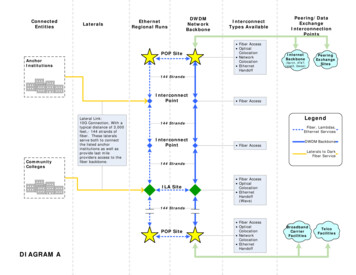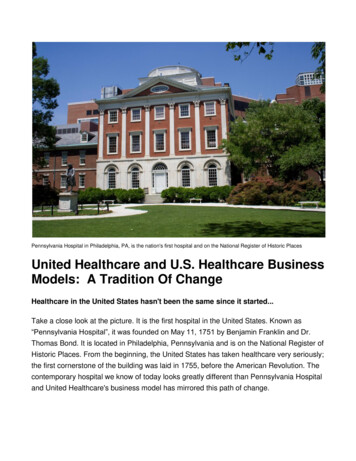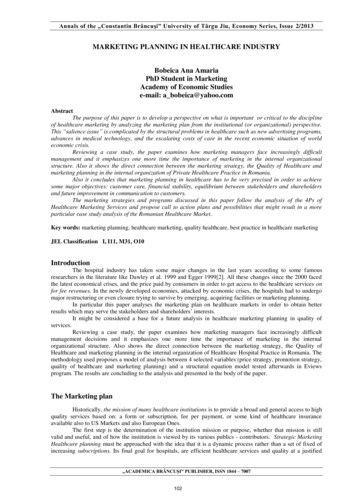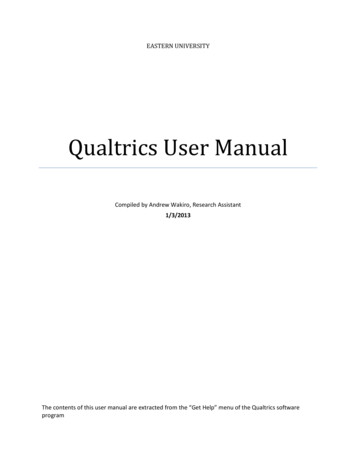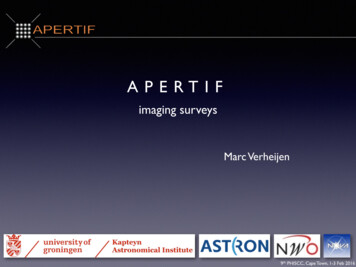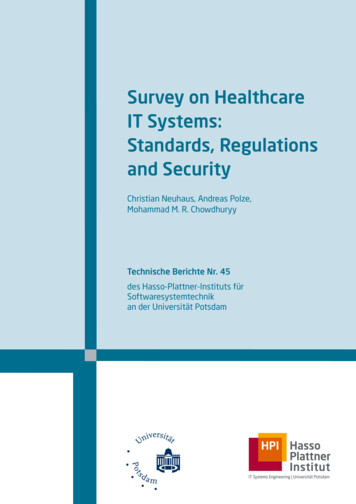
Transcription
Survey on HealthcareIT Systems:Standards, Regulationsand SecurityChristian Neuhaus, Andreas Polze,Mohammad M. R. ChowdhuryyTechnische Berichte Nr. 45des Hasso-Plattner-Instituts fürSoftwaresystemtechnikan der Universität Potsdam
Technische Berichte des Hasso-Plattner-Instituts fürSoftwaresystemtechnik an der Universität Potsdam
Technische Berichte des Hasso-Plattner-Instituts fürSoftwaresystemtechnik an der Universität Potsdam 45Christian Neuhaus Andreas Polze Mohammad M. R. ChowdhuryySurvey on Healthcare IT SystemsStandards, Regulations and SecurityUniversitätsverlag Potsdam
Bibliografische Information der Deutschen NationalbibliothekDie Deutsche Nationalbibliothek verzeichnet diese Publikation in derDeutschen Nationalbibliografie; detaillierte bibliografische Daten sindim Internet über http://dnb.de/ abrufbar.Universitätsverlag Potsdam 2011http://info.ub.uni-potsdam.de/verlag.htmAm Neuen Palais 10, 14469 PotsdamTel.: 49 (0)331 977 4623 / Fax: 3474E-Mail: verlag@uni-potsdam.deDie Schriftenreihe Technische Berichte des Hasso-Plattner-Instituts fürSoftwaresystemtechnik an der Universität Potsdam wird herausgegebenvon den Professoren des Hasso-Plattner-Instituts für Softwaresystemtechnikan der Universität Potsdam.ISSN (print) 1613-5652ISSN (online) 2191-1665Das Manuskript ist urheberrechtlich geschützt.ReportChristian Neuhaus, Andreas Polze: Hasso Plattner Institute at Potsdam University,Potsdam, GermanyMohammad M. R. Chowdhury: Postdoctoral Fellow at UNIK-University Graduate Center,Kjeller, NorwayOnline veröffentlicht auf dem Publikationsserver der Universität PotsdamURL RN .org/urn:nbn:de:kobv:517-opus-51463Zugleich gedruckt erschienen im Universitätsverlag Potsdam:ISBN 978-3-86956-128-8
IT systems for healthcare are a complex and exciting field. One the one hand, thereis a vast number of improvements and work alleviations that computers can bring toeveryday healthcare. Some ways of treatment, diagnoses and organisational tasks wereeven made possible by computer usage in the first place. On the other hand, thereare many factors that encumber computer usage and make development of IT systemsfor healthcare a challenging, sometimes even frustrating task. These factors are notsolely technology-related, but just as well social or economical conditions. This reportdescribes some of the idiosyncrasies of IT systems in the healthcare domain, with aspecial focus on legal regulations, standards and security.
Contents1. Introduction52. Healthcare and IT2.1. Characteristics of Healthcare IT . . . .2.1.1. Sensitivity of Medical Data . .2.1.2. Strong legal regulation . . . . .2.1.3. Distributed Nature . . . . . . .2.1.4. Heterogeneity of Systems . . . .2.1.5. Usability requirements . . . . .2.2. Benefits and Barriers of Healthcare IT2.3. Applications . . . . . . . . . . . . . . .2.3.1. Electronic Healthcare Record .2.3.2. Clinical Decision Support . . .2.3.3. Care Documentation . . . . . .2.3.4. Laboratory Data Systems . . .3. Legal regulations relevant to eHealth3.1. ISO Standards . . . . . . . . . . . . . . . . . . .3.2. Health Insurance Portability and Accountability3.2.1. HIPAA privacy rule . . . . . . . . . . . .3.2.2. HIPAA security rule . . . . . . . . . . .3.2.3. HITECH . . . . . . . . . . . . . . . . . .3.3. The European Union . . . . . . . . . . . . . . .3.3.1. EU Directive 95/46/EC . . . . . . . . .3.3.2. EU Directive 2002/58/EC . . . . . . . .3.3.3. EU Directive 93/42/EEC . . . . . . . . .3.4. National regulations . . . . . . . . . . . . . . .3.4.1. Germany . . . . . . . . . . . . . . . . . .3.4.2. Norway . . . . . . . . . . . . . . . . . .3.4.3. Austria . . . . . . . . . . . . . . . . . .4. Medical data standards4.1. Interoperability . .4.2. List of Standards .4.2.1. openEHR .4.2.2. EN 13606 .3. . . . . . . .Act (HIPAA). . . . . . . . . . . . . . . . . . . . . . . . . . . . . . . . . . . . . . . . . . . . . . . . . . . . . . . . . . . . . . . . . . . . . . . . . . . . . 121212222
4.2.3.4.2.4.4.2.5.4.2.6.4.2.7.ISO/IEEE 11073 . . . . . . . . . . . .LOINC . . . . . . . . . . . . . . . . . .Snomed CT . . . . . . . . . . . . . . .Health Level 7 (HL7) . . . . . . . . . .Clinical Document Architecture (CDA).5. Security, Safety and Privacy in eHealth5.1. Challenges . . . . . . . . . . . . . . . . . . . . . .5.1.1. Sensitivity of Medical Data & IT systems .5.1.2. Public skepticism . . . . . . . . . . . . . .5.2. Security & Safety Threats . . . . . . . . . . . . .5.3. Security Goals . . . . . . . . . . . . . . . . . . . .5.4. Practical Applications . . . . . . . . . . . . . . .5.4.1. Identity Management . . . . . . . . . . . .5.4.2. Access control . . . . . . . . . . . . . . . .5.4.3. Secure Information Transmission . . . . .5.4.4. Security Audit . . . . . . . . . . . . . . .5.5. Research . . . . . . . . . . . . . . . . . . . . . . .5.5.1. Reviewing access control models . . . . . .5.5.2. Evaluating policy languages . . . . . . . .2223232425.26262628282929293032333333346. Summary36A. Solutions & ProductsA.1. Interoperable Delivery of European eGovernment Services toministrations, Business and Citizens (IDABC) . . . . . . . .A.2. Germany: Elektronische Gesundheitskarte . . . . . . . . . .A.3. Norwegian healthcare system . . . . . . . . . . . . . . . . .A.4. Austria: e-Card . . . . . . . . . . . . . . . . . . . . . . . . .A.5. Imprivata . . . . . . . . . . . . . . . . . . . . . . . . . . . .A.6. Sentillion . . . . . . . . . . . . . . . . . . . . . . . . . . . . .A.7. CA Technologies Security Solutions . . . . . . . . . . . . . .A.8. CAREfx . . . . . . . . . . . . . . . . . . . . . . . . . . . . .A.9. IBM Tivoli Access Manager . . . . . . . . . . . . . . . . . .A.9.1. HealthCast, Inc . . . . . . . . . . . . . . . . . . . . .A.10.Sense . . . . . . . . . . . . . . . . . . . . . . . . . . . . . . .A.11.Siemens healthcare . . . . . . . . . . . . . . . . . . . . . . .A.12.Nexus Medfolio . . . . . . . . . . . . . . . . . . . . . . . . .A.13.ICW Lifesensor . . . . . . . . . . . . . . . . . . . . . . . . .A.14.Google Health . . . . . . . . . . . . . . . . . . . . . . . . . .A.15.Secure idenTity acrOss boRders linked (STORK) . . . . . .A.16.Netc@rds . . . . . . . . . . . . . . . . . . . . . . . . . . . .A.17.epSOS . . . . . . . . . . . . . . . . . . . . . . . . . . . . . .394public Ad. . . . . . . . . . . . . . . . . . . . . . . . . . . . . . . . . . . . . . . . . . . . . . . . . . . . . . . . . . . . . . . . . . . . . . . . . . . . . . . . . . . . . . . . . . . . . . . . . . . . . . . . . . . . .394041424343444445454546464747484849
1. IntroductionComputers are now widespread among almost every aspect of our lives, and in many casestheir introduction brought tremendous benefits. Some tasks were made considerably easier, some were even made possible in the first place – such as extensive computationaltasks and information search over very large amounts of data. Especially administrativeprocesses and information exchange of large organizations could not function withoutcomputers anymore. Computers facilitate these tasks by providing information where itis needed.A sector that depends very much on information but seems to lag behind these developments is the domain of healthcare[5]. In terms of computer usage, hospitals are evenseem to be outdone by the public administration: collection of data is mostly done onpaper and is seldomly fed into a computer system. The little data that does reach a computer system usually stays in isolated systems, such as a database for lab analysis values.However, especially in the healthcare domain, a closer integration of systems and a useof computer-aided data processing could be very helpful (see section 2.2). Like almost noother domain, quality of healthcare depends on the availability of data. When a clinicaldecision has to be made, all the required information has to be available[4]. Integrationof Information and Communication Technology (ICT) enables faster feedback, remotemonitoring and analysis and above all ensure mobility of individuals across countries.Neither these benefits come for free, nor can they be achieved without proper knowledgeof the pitfalls and complexities specific to the domain of healthcare. This report triesto show the most notable characteristics of this domain, with a special focus on legalregulations, standards and security and privacy aspects.The report is structured as follows:Chapter 2 gives an introductory overview of the characteristics and adversities of thedomain of software development for IT systems in healthcare.Chapter 3 describes the most noteworthy sources of legal regulations concerning thedevelopment of IT systems and software in the healthcare domain.5
Chapter 4 explains the importance of interoperability of medical devices and softwarein the healthcare domain and introduces the most important data and communicationstandards that enable the development of interoperable products.Chapter 5 gives an introduction to the computer system security from a scientificperspective. It explains the very high importance of security and privacy considerationsin the healthcare domain and shows by which technical means security goals can beachieved.Chapter 6 summarizes the report. It lists the key points to keep in mind when dealingwith software development for healthcare.Appendix A presents a selection of industry solutions and describes their properties.6
2. Healthcare and ITThis chapter examines the distinctive features of processing medical data in computersystems, how it is possible to benefit from that and identifies the obstacles, namely thesecurity and privacy concerns. The descriptions of healthcare IT systems present themotivations of focusing on the security and privacy aspects in healthcare IT sector.2.1. Characteristics of Healthcare ITComputer systems for the healthcare domain differ greatly from other domains of ITin certain aspects. The reason for this are the high demands made on these computersystems – because of the special sensitivity of medical data.2.1.1. Sensitivity of Medical DataThe term medical data applies to all data that is related to a persons health and medicalhistory. Data of this kind is considered especially sensitive and in need of protection.This is understandable, since even fragments of medical data can reveal very much information. In this, medical data is very side-channel -prone[36]: For example, mereprescriptions of specific HIV-suppressive drugs clearly indicate that the patient is HIVpositive, although the prescription of the drug itself is not a diagnosis at all and maysound harmless and unimportant to someone unfamiliar with the name of the drug. Ingeneral, information about STDs opens up room for speculations on how these wereacquired. And a patient may simply want to keep quiet about a condition he’d ratherdeal with himself.The sensitivity of medical data and medical IT systems is explained in more detail insection 5.1.1.2.1.2. Strong legal regulationDue to the sensitivity of medical data, healthcare IT systems are subject to strong legalregulation: The processing, storage and dissemination of medical patient informationis subject to many laws and regulations, which vary greatly between different countriesand continents (see section 3).7
2.1.3. Distributed NatureAs an additional challenge, medical IT systems tend to be highly distributed since medical treatment is a distributed process as well. Traditionally, distribution of computersystems would span over a single hospital. Today, however, cooperation between medicalinstitutions crosses the borders of hospitals and even countries and include very largeinstitutions as well as single doctors offices. The connection may even reach into thepatients home, as telemedicine solutions become increasingly popular.As a consequence, rights management and privacy policy definitions for processed information are not easy to determine: Many users from many domains with differentfunctions may need access to stored medical data at different times. The roles that theusers play may change at any time. An example for this are context-dependent privileges: The user rights for data access may depend on the context of the situation (i.e.emergency access).2.1.4. Heterogeneity of SystemsA lot is to be gained by the introduction of modern IT systems in healthcare – this,however, does not mean that computer usage is totally new to this domain. In fact,computer have been used a lot in the healthcare domain, but these solutions are often legacy systems, independently developed insular solutions for single customers andincompatible to other systems [43].Shortcomings of legacy systems The most important problem with many legacy ITsolutions is the lack of interoperability. The desired level of integration is businessprocess integration so that administrative and clinical processes can make use of ITcapabilities with very little manual intervention. This, in turn, requires IT solutions tobe interoperable on the functional level and on the data level. Functional integrationrequires the exposure of implemented functionality to the outside of the systems – so itcan be used by other computer systems over a network. Data integration stands for theavailability of interfaces for exchange of data with other systems – and a shared datamodel and a shared semantic understanding of exchanged data. These interfaces areoften missing in legacy systems.Furthermore, legacy systems often suffer from typical software engineering shortcomingssuch as poor maintainability and extendability. These problems often prevent furtheruse when the environment of these systems changes and requires updates and adaptions.Rip-and-Replace vs. Integration In spite of these problems, legacy systems are often kept in use as long as possible. Healthcare is a higly specialized domain – andmany legacy solutions are custom developed for their application domain and servetheir purpose well. Special application scenarios may even be beyond the capabilitiesof commercial off-the-shelf software and encapsulate domain knowledge and workflow8
processes that cannot be easily extracted. Additionally, training personnel for a newsoftware product may be very expensive.Therefore, existing IT solutions are often re-engineered and adapted to be integratedinto lager new IT systems instead of replacing them.2.1.5. Usability requirementsHealthcare is a domain with high cost-pressure and its employees – nursing staff andphysicians – are facing a high workload. Therefore, IT solutions in healthcare shouldintegrate into the workflow of staff and slow it down as little as possible. If a new solutions does induce additional efforts, its rewards must clearly outweigh these efforts[6].As a consequence, products and solutions should fulfill high usability requirements ininterface design and operation.This is especially important for the design of solutions for access control mechanisms:These may considerably slow down work by requiring the user to remember many different passwords and enter them frequently. As a consequence, these mechanisms are oftencircumvented and rendered useless[23]. More thoughtful approaches such as Single-SignOn and RFID-tokens could remedy such problems.2.2. Benefits and Barriers of Healthcare ITHealthcare is a very complex domain that depends very much on the availability of information. The main responsibility of a physician it to make decisions on a treatmentfor patients. The indispensable foundation for these decisions is the availability of allrelevant information from the patients medical history. This involves the treatment process, diagnoses and recorded vital parameters. The physicians task of decision-makingtherefore can be seen as gathering and acting on information[25]. Computer can facilitate this work tremendously, as gathering, management and presentation of informationis their prime strength (see Electronic Health Records, 2.3.1).Computer systems can also be very helpful with tasks related to resource planning,such as creating schedules for long-term treatments in accordance with the availableresources at the hospital. It may be hard for a person to keep an overview over severaltimetables, which is fairly easy to manage by computers. The result could be a well tunedschedule for the patient, and offers the clinics the possibility to maximize the usage oftheir treatment facilities. This is a tremendous economical advantage, since medicalequipment can be costly to maintain. A good overview over a patient’s treatment canalso be useful to avoid redundant treatment, which may occur if different treatmentfacilities do not have complete information about the patient’s treatment history.Even though the use of IT systems in could bring many benefits, simplifications andalleviations (see 2.2) the adoption process is slow and tedious. Various factors can be9
identified that impede this adoption process[24]:One problem encumbering the adoption of healthcare IT technology is the unequaldistribution of costs and benefits of such systems[24]. Health funds pay for patienttreatment, but do not directly reward investments into new technologies. The introduction of new technology such as electronic health record costs money and possibly takes along time to amortize, this is often unaffordable to smaller doctor’s offices. Additionally,the economical advantages of healthcare IT will likely start to take effect when theywill have been adopted by the majority of healthcare institutions. This may pose aneconomical penalty to the ones adopting it first.Moreover, medical IT systems are considerably harder to develop, since they are subjectto strong legal regulation. Specifically, medical devices and software have to undergo acomplicated certification process, which is not only expensive but also introduces variousrequirements, such as redundancy by dual-channel system design.A very important requirement on medical IT system is the ability of different systemsto interoperate. Currently, however, many competing standards exist on how medicalsystems can be interconnected and exchanges data. Since there is no one-fits-all solutionto this problem, it contributes to the cost and complexity of the design and deploymentof medical IT systems.However, the most critical issue for the adoption of IT systems in healthcare are concernsabout how security and privacy can be guaranteed in such systems which is the mainfocus of this report. This is described in more detail in section 5.2.3. Applications2.3.1. Electronic Healthcare RecordRecording and retrieval of medical information in electronic form is the core applicationfor information technology in healthcare[25]. The most commonly known concept of thisis the Electronic Healthcare Record (EHR):1. we define the electronic healthcare record (EHR) as digitally stored healthcare information about an individual’s lifetime with the purpose of supporting continuity of care, education and research, and ensuring confidentialityat all times.[26]The information typically recorded by an EHR are clinical observations, vital signs, diagnoses and examination results, treatment plans and drug prescriptions. As medicinebecome more complex, the amount and diversity of information that has to be managed and used in healthcare grows rapidly. Traditionally, this has been done on paper –1Also referred to as Electronic Health Record or Electronic Medical Record10
but paper-based solutions are hardly suited to meet today’s needs[25]: It may be hardto read someone else’s handwriting. Parts of medical records are likely to be missing,because over time, it becomes impossible to keep all records in one place due to spacerestrictions. Also, parts of a record might get lost. Most importantly, if paper documents should be used in more than one place simultaneously, they have to be tediouslyduplicated.The use of an EHR offers a far more convenient way to handle medical data[26]: In itsideal form, an EHR keeps data quickly accessible and available to the clinician. Datacan be used in more than one place at a time. Coping with the weight of large, heavyfolders becomes obsolete. Instead, data can be flexibly viewed on mobile, handheld devices. By structuring the data, making it searchable and introducing user-specific view,data access becomes very flexible.Apart from direct benefits for the patient, the use of electronic health record also provides the basis for data collection for clinical studies. However, for this purpose, patientdata confidentiality and privacy considerations have to be the first priority.A requirement for the successful introduction of EHR solutions is that the use of thissolution should avoid additional workload for its users. They have to be designed insuch a way that they are at least as convenient to use as the paper-based alternatives,otherwise they are likely to be rejected[25].2.3.2. Clinical Decision SupportComputer support does not have to be limited to merely providing recorded informationto the physician. It can can synthesize new information, such as suggestions for diagnoses, treatment options or expected development of a patients medical condition: Thisapplication is called Clinical Decision Support[20].These suggestions are made byconnecting the available data in a patient’s electronic health record and general medicalknowledge. There are various ways the clinicians work can be assisted: Lab values can be analyzed for critical patient conditions. If such a condition isfound, an alert is raised.[4] Reminders are sent to doctors for ordering preventive measures[25]. Suggestions or warnings are issued to remind clinicians of compliance with standardized medical care guidelines[12].2.3.3. Care DocumentationIT systems in healthcare can also record patient-related information beyond actual vitalsigns and examination results as in the classic health record (see section 2.3.1): Thecare carried out by the nursing staff has to be carefully documented. This is helpful for11
several reasons: For one thing, nursing processes have to be documented by hospitalsin order to be able to prove that the necessary care and treatment steps have beenperformed. Furthermore, every single unit of work has to be documented to be able tobill the health insurance company of the patient accordingly. When implemented in auser-friendly fashion, electronic care documentation can be perceived as helpful by thestaff[35].2.3.4. Laboratory Data SystemsComputer systems for storing, processing and distribution of laboratory data is probably the oldest most widespread form of computer usage in healthcare. These systemswere very effective since the beginning as typical lab results are the form of data that ismost easily processed by computers: They are numerical values and the different kindsof measurements are limited to those provided by the lab, thus there is a limited datamodel that has to be supported.The function of laboratory data systems (LDS) traditionally covers handling of lab results from the point of their creation to the moment they are being accessed and viewed.Therefore, LDS gather the measurements automatically from the capture devices andstore them in a database. The data is then accessible over the network with viewerapplications at the point of care.Because of the long history of LDS, many custom-developed proprietary legacy solutionsexist today, that are often closed-off information silos. However, LDS have been facingnew challenges lately: Information silos have to be opened and data has to be accessiblethrough interoperable interfaces, following open data standards (see chapter 4) – to beused in applications such as electronic health records (see section 2.3.1). Flexible importand export of data is also necessary for cases when special analyses have to be outsourcedto more specialized labs and data has to be re-imported from those labs.12
3. Legal regulations relevant toeHealthThe domain of healthcare - and consequently healthcare IT systems - is subject to agreat variety of laws and regulations almost like none other. This chapter describes themost notable sources of regulation relevant to healthcare IT systems.Complexity and multiplicity of regulations Laws and regulations are concerninghealthcare IT systems are both numerous and and far-reaching. Both properties account for the complexity of developing healthcare IT systems and ensuring they arecompliant with the corresponding regulations.Several causes are responsible for the large amount of regulations. For one thing, manylaws were put into effect when development of healthcare products was hardly internationally coordinated and normed, therefore numerous country-specific regulations. Furthermore, some regulations apply to healthcare IT systems that initially only targetednon-computerized medical products. These laws were partly and gradually adapted toalso cover IT aspects or amended by new additional laws. Lastly, federalism like in theEuropean Union delegates certain regulatory authority to its member countries, thuscreating local regulations that may have to be taken into account.For certain types of medical products and IT systems, the implications of the regulationsand laws are quite profound and demanding, especially in respect to product certificationand the complexity of this process. Even though this is a huge cost driver in productdevelopment, these regulations make sense as lives regularly depend on the concernedproducts.It is notable that for products that to not fall into the highest categories of risk, selfcontrol mechanisms apply. This means that the manufacturer itself is required to ensurethat his product complies to the corresponding regulations.3.1. ISO StandardsInternational Organization for Standardization (ISO) and International Electrotechnical Commission (IEC) provides best practice recommendations on information securityrisks, management and controls through its ISO/IEC 27000-series standards. The standards cover the fundamental requirements of information management systems, provide13
guidelines and principles for the implementation of such systems. Among the standards,ISO 27799:2008 and ISO/TR 27809:2007 meant for health informatics. The former provides guidelines for designing health sector specific information management systemsfollowing ISO/IEC 27002. The later provides control guidelines for patient safety withinsuch systems.ISO/IEC Joint Technical Committee 1 (JTC1) deals with all matters of InformationTechnology including develop, maintain, promote and facilitate IT standards by enterprises and users concerning the security of IT systems and information.3.2. Health Insurance Portability and Accountability Act(HIPAA)The US congress promulgated HIPAA in order to ensure security and privacy of individually identifiable health information. HIPAA deals with security and privacy throughthe HIPAA privacy rule (standards for privacy of individually identifiable health information) and the HIPAA security rule (security standards for the protection of electronichealth information). The privacy rule ensures the flow of health information needed forquality care by addressing proper use and disclosure of health information. The securityrule aims at protecting the privacy of individuals’ health information by adopting newtechnologies with a goal of achieving improved quality and efficiency of patient care. Itoperationalizes the protection mechanisms contained in the privacy rule. This sectionprovides the summary of the HIPAA privacy and security rules. The HIPAA privacy andsecurity rules are applied to health care providers and non-health care providers supporting the health care providers holding or transmitting health information in electronicform.3.2.1. HIPAA privacy ruleThe privacy rule protects the following individually identifiable health information heldor transmitted by the covered entities. Common identifiers (e.g. name, address, birth date, social security number); Past, present or future physical and mental health or condition; Provision of health care to individuals; Past, present or future payment provision for health care.However, there are no restrictions to use or disclose health information that cannotidentify an individual in any way.The covered entities are permitted to use or disclose the health information for thespecific purposes (e.g. treatment, payment etc.). The entities can disclose health information for research or public interest withholding certain specified direct identifiers.14
The covered entity must obtain explicit authorization to use and disclose of personallyidentifiable health information for purposes other than treatment, payment and relevanthealth care operations. While using and disclosing, the covered entities should use anddisclose the minimum amount of information needed to accomplish the intended purpose. In this regard, appropriate policies and procedures should be in place to restrictthe use and disclosure of information. When other entities request for the information,a proper and explicit trust ag
Technische Berichte Nr. 45 des Hasso-Plattner-Instituts für Softwaresystemtechnik an der Universität Potsdam Survey on Healthcare IT Systems:
